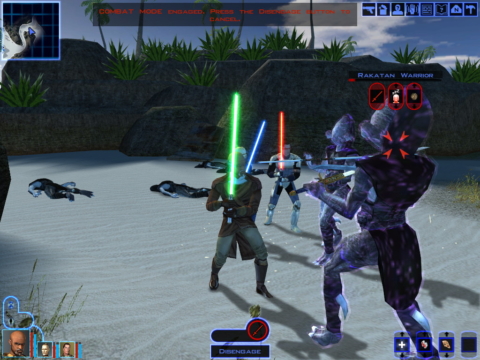
Star Wars: Knights of the Old Republic II: The Sith Lords
Written by: Rik
Date posted: May 16, 2022
- Genre: RPG
- Developed by: Obsidian Entertainment
- Published by: LucasArts
- Year released: 2005
- Our score: 8
The first Knights of the Old Republic game was not without its twists, turns and surprises, but in many ways it remained a conventional ‘classic’ Star Wars adventure, at least as remembered by a certain generation: a tale of good vs. evil, a baddie with a mask, and a big space station that needs to be blown up. Not that there’s anything wrong with that, of course, and despite being a little bit obsessed with its relationship to Mass Effect, your correspondent found it all held up pretty well.
A sequel followed pretty quickly, so much so that Bioware considered the short turnaround time too ambitious, which eventual developers Obsidian ultimately found to be the case as they struggled to get it finished. With this in mind, it’s perhaps not surprising that Knights of the Old Republic II: The Sith Lords offers little significant improvement or innovation from a technical standpoint. However, what it does do is take an unexpectedly different narrative path from (and feature surprisingly little crossover with) its much-lauded predecessor.
5 years after the events of KOTOR (so: 3,995 years before The Phantom Menace?), we find our new unnamed hero, unconscious, in familiar surroundings (aboard the Ebon Hawk – the Millennium Falcon a-like of the first game) and in need of some assistance from another member of the returning cast, the astromech droid T3-M4, in a skippable tutorial that’s nevertheless worth playing through, even if you’re familiar with the general gameplay mechanics from last time around. You’ll also be introduced to one of the new additions, a crafting element through which you can break down unwanted items of inventory and turn them into something more useful, depending on the character in question’s skills in repair, security and treat injury. (You know, kind of like turning things into Omni-Gel in the first Mass Effect [that’s quite enough of that, now – FFG reader]). Plus, there are some nice visual moments in there too, as your little droid ventures onto the ship’s exterior in its quest to perform the requisite repairs.
Any familiar story elements are somewhat of a red herring, though, in terms of links to the first game, the events of which are referenced but generally given little prominence. Instead the focus, particularly during the opening exchanges, is more on who exactly your character is, apart from someone who doesn’t have any clothes, and seems in no desperate rush to find them, while clanking through early battles with rustic weapons, dressed only in his undercrackers. (Of all the gaming hints I never thought I’d have to Google, a query about whether I’d somehow overlooked an early locker or storage crate because I’d played for a solid hour with my character in a state of undress has to be up there).
Apart from the growing realisation that KOTOR II isn’t going to be a sequel in the traditional sense of reuniting the majority of the cast of the previous game, answers are fairly slow in coming. Indeed, however momentous the climax of KOTOR might have seemed, it doesn’t appear to have made much of an impact on the characters you come across here, or indeed the general fortunes of the Jedi, who have largely been killed off, with the remainder forced into hiding by the Sith Lords of the game’s title, who are obsessed with the eradication of their light-side brethren. As a Force-adjacent character, your eventual task is to track down the remaining Jedi and either recruit or kill them, depending on which side of the Force appeals from this point in.
And so, the structure of the main quest remains largely as before: go to a few planets, in the order of your choosing, and find these Jedi masters while getting involved in all kinds of local trouble – optional quests and battles with generic baddies – and building your character into the kind of super-hard badass that will be able to cope with the demands of the final endgame.
Before I pass too much further comment I should come clean here and say that I played the un-modded retail Steam version, which I understand comes with its own tweaks and updates from the 2005 boxed original (including controller and widescreen support), but does not include the full suite of fixes and restored content made available through the dedicated efforts of third parties, fully endorsed by the developers as the ‘definitive’ version of the game, fixing and finishing things that were cast aside in the rush to release.
By all accounts, that’s the superior experience, but part of me was simply curious to see what state it was in by default, to what extent the glitches and bugs of legend were noticeable and/or affected the experience, and how obvious the cut corners and missing content might be to the uninitiated first-timer. It might sound a bit mad, but that was the choice I made. Having played once and enjoyed it, I’ll be certain to check out the restored content mod if the mood for a second run-through ever takes me.
My experience with this version was certainly of a rather glitchy game, but nothing qualified as anything more than a minor annoyance. The most common bug was the camera getting stuck pointing at the ceiling, often after using a workbench to break down or repair items, necessitating a save and return to the main menu. The start of in-engine cut-scenes and dialogue also seem to threaten (but never deliver) a crash: I think the same was true of the first game, although there are many more cases here of characters facing the wrong way while talking to you.
In the game itself, there’s a new feature which in theory allows you more control over your squad while controlled by the AI: you can give them instructions, for example, to be aggressive in combat, use ranged weapons from a distance, or to simply stay put. While this does seem to be effective at times, on more than one occasion my colleagues definitely did not follow my instruction to remain stationary instead of blundering straight into a minefield. Thankfully the consequences were relatively minor, in a world of healing powers and medkits, but it was a bit annoying nonetheless.
Otherwise, it was largely a case of occasionally wondering exactly how to complete some minor unresolved quests and certain options not being very well signposted, to the extent that there seems to be significant potential for missing out on interesting stuff in terms of developing relationships with other characters and their skills: for example, some non-Jedi can apparently be trained in the use of the Force, but whatever conversation paths and choices were required to effect this, they certainly weren’t all that obvious to me.
While the first game’s system of prompting you to chat to party members when new dialogue options became available was a bit clunky, its absence here means you have to be diligent in checking in with them all yourself, and quite often they don’t seem to have anything new to say. There is an ‘influence’ system where you please or displease individual companions with your responses and actions but, as far as I could tell, I only seemed to have an impact on one other crewmate throughout the course of my playthrough.
All of that said, the characters and story are arguably much more interesting than in the first game. The motivations of your companions (and your character, come to think of it) are much more ambiguous, and doubts are seeded through dialogue scenes between your gang while the player is absent. KOTOR II does a better job in general of including all the crew regardless of which ones you favour as party members, although this approach does include a semi-frequent forcing of the hand by putting you in control of individual party members for certain sequences, which can make for some tricky moments, as well as a slightly more enjoyable splitting of the party into two groups, forcing you to balance out skills and favoured characters across them.
Without giving too much away, the story leans into the dark side more than in the first game, which pretty much devolved into ‘do the right thing/do the wrong thing’ type choices, with very little incentive given for the latter. You can of course still favour the light side in KOTOR II and, being a big goody-two-shoes, I did, but this time around taking the other path seems much more understandable and arguably even makes more sense, in context, rather than just being an option for sociopaths to see what happens if they go around behaving like a dickhead. We mentioned last time the parallels between decision making in KOTOR and the Paragon and Renegade paths in Bioware’s later space epics, and there’s arguably some foreshadowing here of the choices on offer in Obsidian’s Alpha Protocol: fewer opportunities to simply have your cake and eat it, and an acknowledgement that even trying to do the moral and correct thing can still have unwanted consequences.
Gameplay-wise, there’s not a massive amount of change from the first game, and on normal difficulty at least, it should be fairly easy for most to work out how to properly manage their stats, squad and powers. Possibly it forced me to be a little more refined in my approach than in the first game, in which I was able to mostly ignore the fact that wearing armour blocked off most Force powers, as I didn’t seem to need any of those I was missing. That particular quirk seems to have been gently rebalanced here, partly through the introduction of special Jedi robes that also have armour-like properties, and I made better use of both defensive and offensive Force powers this time around rather than just charging into combat and hammering Force Heal afterwards. There’s been a little bit of streamlining when it comes to the interface, and handling multiple weapons – particularly switching between melee and ranged – is now more easily managed.
Otherwise, it’s largely a case of ‘as you were’, with various assets from the previous game being re-used, from the main character’s running animation (with which there remains plenty of opportunity to become familiar during various bits of backtracking, to the extent that I gave some consideration to the question of whether the movement of my male avatar’s upper thighs and buttocks was entirely natural or peculiarly robotic) to the return of a couple of the same planetary locations. In the case of the latter, it’s sort of fair enough and easy to justify in terms of going back to the same places that have been changed by events, but even so, these sections also serve to reinforce the impression that Obsidian were working under considerable time constraints. Along the same lines, things that didn’t really need to return, like the swoop racing sections, seem out of place and somewhat shoehorned in here, to no great effect other than to perhaps emphasise vague notions of continuity with the first game that otherwise appear to be of limited importance.
Speaking of things that seem a bit rushed, the ending here is longer and more tedious than it might be to play through, especially in exchange for the comparatively meagre narrative pay-off. The first game occasionally separated you from your companions for particularly tricky bits, but here there’s a lot of wandering through similar rooms on your own and hacking through waves of Sith and Dark Jedi before you finally confront the ultimate big bad.
And it’s a shame that this is where the series ends: whatever plan was in place to further join the different strands of story from these first two games and bring them all together for a satisfying resolution in a third (kiboshed by problems at LucasArts, and possibly the switch to a new generation of console hardware) it doesn’t look like they’ll now be realised, although Bioware did offer some continuation through their later MMO The Old Republic, even though that’s set in a slightly different time period, and not necessarily something of interest to those who enjoyed these earlier single-player instalments.
As things stand, though, KOTOR II comes with our wholehearted recommendation: at once completely similar and totally different from the previous game, whose faults and idiosyncrasies – in this retail version at least – are more than counterbalanced by its novel and interesting approach to telling a Star Wars story. Certainly the equal of, if not a slight improvement upon, its predecessor.

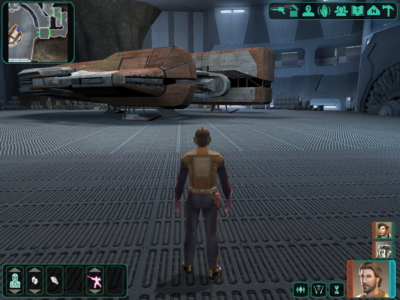
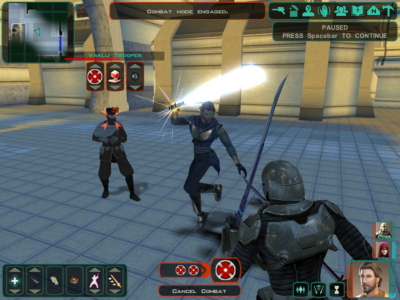
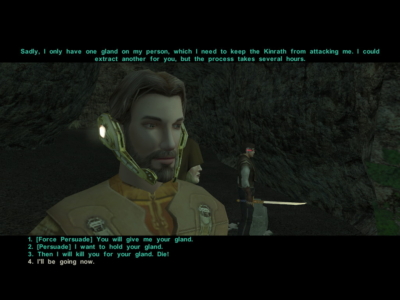
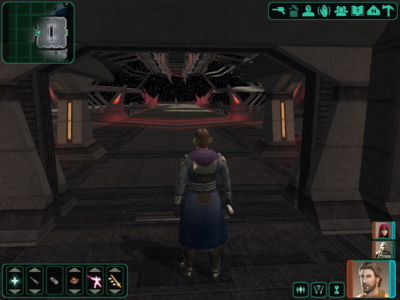
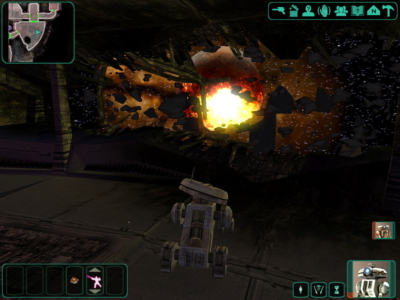
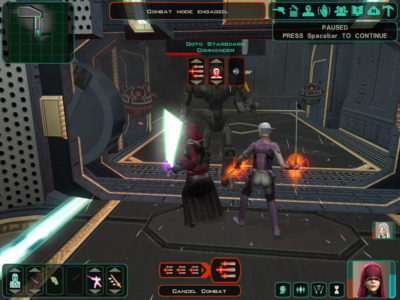

 Posts
Posts
Hi Rik!
That “I want to hold your gland” up there, in the sreenshot.
Possibly, a draft title for a song by The Beatles?
Heh… heh heh heh.
Seriously, thanks for covering both titles.
I was considering them on GOG, but I already have a lot of backlog. Thanks to your help, at least I understand better how they are built and if they are worth the time and money.
Take care.
May 17, 2022 @ 11:52 am
Hi Oleg!
Now that Beatles song, with the revised lyrics, will be going around in my head all afternoon…
Glad you liked the reviews. I picked up both games in some Star Wars mega-bundle some time ago, so it’s taken me a while to get around to them, but am glad I did.
May 18, 2022 @ 12:55 pm